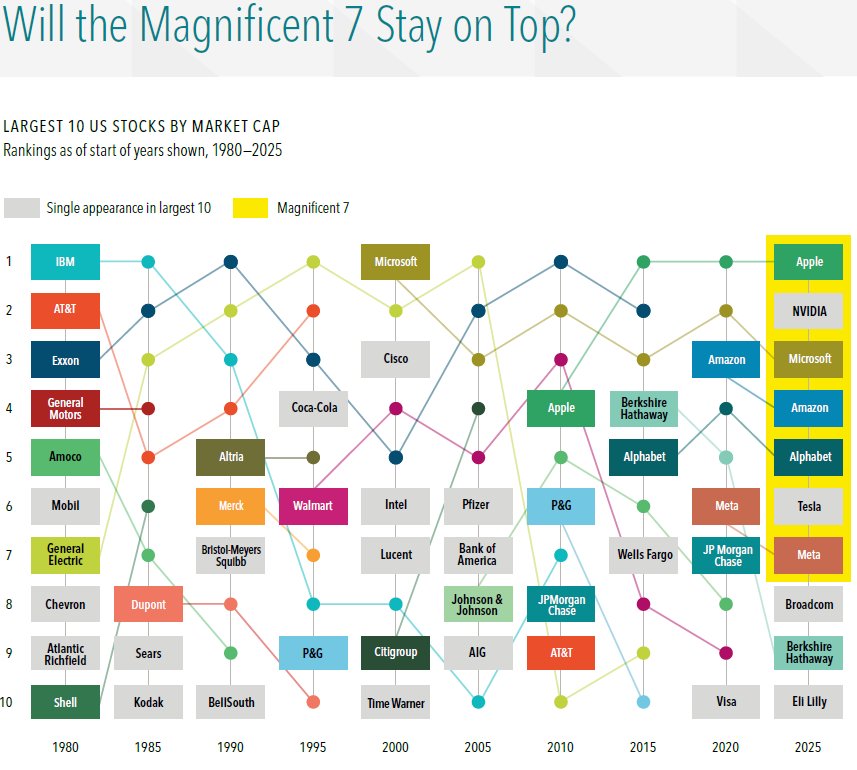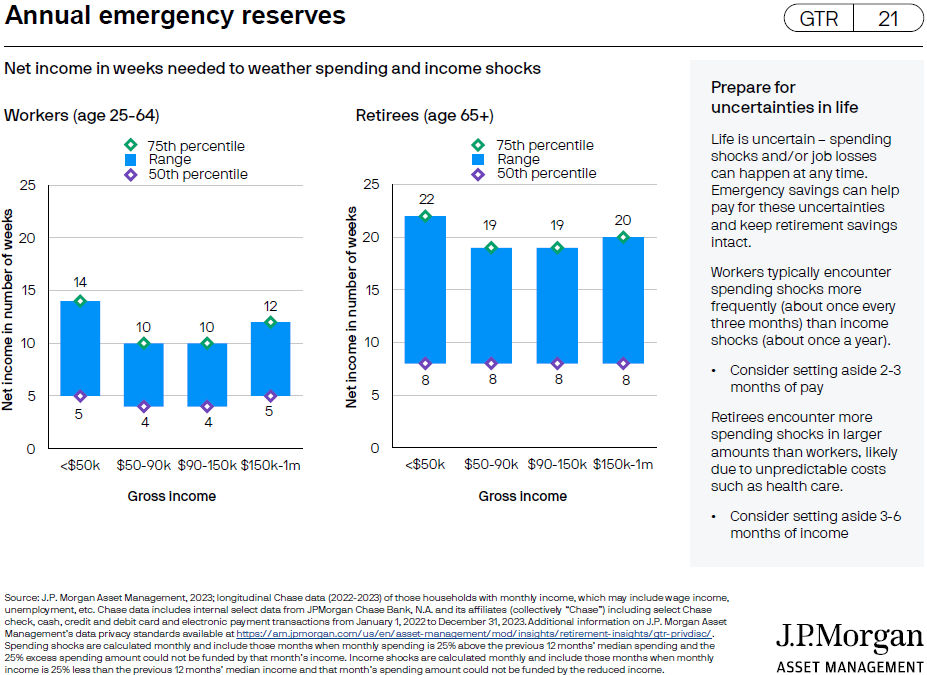
Fun With Charts!
Will the Magnificent 7 Stay on Top?
Over the past few years, the performance of seven stocks (i.e., The Magnificent 7) has resulted in outsized market performance, billions of investment dollars, and an extraordinary amount of publicity. Those seven stocks – Alphabet (Google), Amazon, Apple, Meta (Facebook), Microsoft, Nvidia, and Tesla – are among the 10 largest US stocks. But will they stay there in the years to come?
The following chart, from Dimensional Funds1, shows the 10 largest US stocks – as measured by market capitalization – over the period 1980-2025. And there are important lessons to be learned:
“…only three of the 10 biggest companies from 1980 made the 2000 list – and none of them were in 2025’s Top 10.
“Industries ebb and flow. Technology-focused firms currently dominate the list. But in 1980, six of the 10 largest companies were in the energy sector.”
“New technology doesn’t benefit only tech firms. Throughout history, companies across industries have used technology to innovate and grow.”
If you’re of a certain age, look at the names of some of the companies we grew up with back in 1980. Look at the companies that exited the Top 10 list (or were altogether eliminated) over time, such as Sears, Kodak, Time Warner, AIG, and Lucent. The lesson: while you can make money investing in Magnificent 7, or Top 10 stocks, those investments still require monitoring.
As to the companies that will comprise future lists of the largest US stocks, Dimensional reaches a conclusion we’ve supported for 30 years: “Diversification enables investors to share in the success of today’s top companies while staying positioned to benefit from tomorrow’s market leaders.”
Emergency Reserves: How Much Is Enough?
One question we’re often asked by clients, to include young, old, retired, and everyone in between, is how much cash you should set aside in the event of an emergency. While there is no ‘right’ answer that fits all sizes, JP Morgan2 offers a chart to support their recommendations.
In terms of definition, emergency reserves are funds specifically allocated to cover either an unexpected income shortfall or an unexpected expense. They are not dollars invested for long-term appreciation and do not include funds allocated for a specific purpose (e.g., college tuition, car purchase, etc.). Rather, emergency reserves are dollars set aside for the sole purpose of an unexpected or emergency event. Whether you’re employed or retired, the risk of an income or spending shock is ever-present. (The difference between an income shock and a spending shock is what the terms imply. An income shock refers to unexpectedly earning fewer dollars, such as may occur when a job is downsized or a bonus doesn’t come through. In contrast, a spending shock refers to an unexpected expense, such as a medical bill, car repair, expense for a relative, etc.)
As a starting point, note the recommendations for workers (age 25-64) and retirees (age 65+) in terms of emergency reserves to prepare you for the uncertainties in life:
“Workers typically encounter spending shocks more frequently (about once every three months) than income shocks (about once a year). Consider setting aside 2-3 months of net pay.
“Retirees encounter more spending shocks in larger amounts than workers, likely due to unpredictable costs such as health care. Consider setting aside 3-6 months of income.”
1 “Dimensional Funds, “Will the Magnificent 7 Stay on Top?”, 2025
2 “Annual Emergency Reserves,” Slide 21, Guide to Retirement, J.P. Morgan. 2025.
S.F. Ehrlich Associates, Inc. (“SFE”) is a registered investment advisory firm in New Jersey that offers investment advisory, financial planning, and consulting services to its clients, who generally include individuals, high net worth individuals, and their affiliated trusts and estates. Additional disclosures, including a description of our services, fees, and other helpful information, can be found in our Form ADV Part 2, which is available upon request or on the SEC's website at www.adviserinfo.sec.gov/firm/summary/121356.
If you are an existing client of SFE, it is your responsibility to immediately notify us if there is a change in your financial situation or investment objectives for the purpose of reviewing, evaluating or revising any of our previous recommendations and/or services.
This newsletter is for informational purposes only and is not intended to be and does not constitute specific financial, investment, tax, or legal advice. It does not consider the particular financial circumstances of any specific investor and should not be construed as a solicitation or offer to buy or sell any investment or related financial products. We urge you to consult with a qualified advisor before making financial, investment, tax, or legal decisions.
Information contained herein has been obtained from sources believed to be reliable. While we have no reason to doubt its accuracy, we make no representations or guarantees as to its accuracy. The opinions and analyses expressed herein constitute judgments as of the date of this newsletter and are subject to change at any time without notice. Any decisions you make based upon any information contained in this newsletter or otherwise are your sole responsibility.
No graph, chart, formula, or other device can, in and of itself, be used to determine which securities to buy or sell, or when to buy or sell such securities, or can assist persons in making those decisions.
Any securities mentioned in this newsletter are for illustrative purposes only and should not be construed as investment advice or a recommendation to buy or sell. There is no guarantee that a particular client's account will hold any or all of the securities mentioned in this newsletter. Additionally, from time to time, SFE’s officers, directors, employees, agents, affiliates, or client accounts may hold positions or other interests in the securities mentioned in this newsletter.
Any historical index performance provided herein is for illustrative purposes and includes the reinvestment of dividends and income, but does not reflect advisory fees, brokerage commissions, and other expenses associated with managing an actual client account. An index is an unmanaged group of stocks considered to be representative of different segments of the stock market in general. Index performance does not represent actual account performance. One cannot invest directly in an index. A description of each index mentioned in this newsletter is available upon request.
Any hypothetical performance shown or discussed herein is for illustrative purposes only. Hypothetical performance results have inherent limitations, including: they are generally prepared with the benefit of hindsight; do not involve financial risk or reflect actual trading; and do not reflect the economic and market factors, such as concentration, lack of liquidity or market disruptions, trading costs, and other conditions, that might have impacted our decision-making when managing actual client accounts. Since trades have not actually been executed, hypothetical performance results may have under- or overcompensated for the impact, if any, of certain market factors.
It should not be assumed that future performance of any specific investment, investment strategy, or index (including any discussed in this presentation) will be successful or profitable or protect against loss.
Any forward-looking statements or projections herein are based on assumptions. By their nature, forward-looking statements involve a number of risks, uncertainties, and assumptions that could cause actual results or events to differ materially from those expressed or implied by the forward-looking statements. You should not place undue reliance on forward-looking statements, which reflect our judgment only as of the date this newsletter was published.



